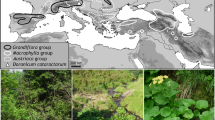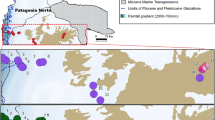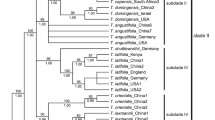Abstract
We investigated the phylogeny and phylogeography of four closely related Ainsliaea species (Asteraceae) on the continental Ryukyu Islands of eastern Asia, which consist of two flood-adapted “rheophyte” and two non-rheophyte (inland) species, based on 12 nuclear microsatellite loci. Phylogenetic analyses using 420 individuals from 26 populations showed that rheophytic A. linearis and A. oblonga are genetically distinct. Each species was clustered with the inland species that occur on the same islands, suggesting a different ancestry for the two rheophytes that evolved independently by local adaptation to flooded habitats. The results from the neighbor-joining clustering and principal coordinate analysis (PCoA) indicate that the southern populations of A. macroclinidioides are distinct lineages and ancestral to the northern populations as well as the other diverse species complex in the Ryukyus. These results suggest a pattern of colonization initially from the Asian mainland to the southern islands, followed by the northern islands via land bridges generated during the Quaternary glaciations. After isolation from southern populations, species radiation and regional differentiation within the northern clade occurred possibly via local adaptation and/or geographic isolation of the subdivided island bridge.





Similar content being viewed by others
References
Adsersen H (1995) Research on islands: classic, recent, and prospective approaches. In: Vitousek PM, Loope LL, Adsersen H (eds) Islands: biological diversity and ecosystem function. Springer-Verlag, Berlin, pp 7–21
Campbell DR (2003) Natural selection in Ipomopsis hybrid zones: implications for ecological speciation. New Phytol 161:83–90
Chiang TY, Schaal BA (2006) Phylogeography of plants in Taiwan and the Ryukyu Archipelago. Taxon 55:31–41
Church SA, Taylor DR (2002) The evolution of reproductive isolation in spatially structured populations. Evolution 56:1859–1862
Crawford DJ (1990) Plant molecular systematics: macromolecular approaches. Wiley, New York
Doyle JJ, Doyle JL (1987) A rapid DNA isolation procedure for small quantities of fresh leaf tissue. Phytochem Bull Bot Soc Am 19:11–15
Edwards CE, Judd WS, Ionta GM, Herring B (2009) Using population genetic data as a tool to identify new species: Conradina cygniflora (Lamiaceae), a new, endangered species from Florida. Syst Bot 34:747–759
El Mousadik A, Petit RJ (1996) High level of genetic differentiation for allelic richness among populations of the argan tree [Argania spinosa (L.) Skeels] endemic to Morocco. Theor Appl Genet 92:832–839
Emerson BC (2002) Evolution on oceanic islands: molecular phylogenetic approaches to understanding pattern and process. Mol Ecol 11:951–966
Evanno GS, Regnaut S, Goudet J (2005) Detecting the number of clusters of individuals using the software structure: a simulation study. Mol Ecol 14:2611–2620
Freire SE (2007) Systematic revision and phylogeny of Ainsliaea DC. (Asteraceae, Mutiseeae). Ann Mo Bot Gard 94:79–191
Goudet J (1995) FSTAT version 1.2: a computer program to calculate Fstatistics. J Hered 86:485–486
Grant V (1981) Plant speciation. Columbia University Press, New York
Hatsushima S (1980) The origin of flora. In: Kizaki K (ed) Natural history of the Ryukyus. Tsukiji-shoten, Tokyo, pp 113–123
Jarne P, Lagoda PJL (1996) Microsatellites, from molecules to populations and back. Trends Ecol Evol 11:424–429
Juan II, Emerson BC, Orom II, Hewitt GM (2000) Colonization and diversification: towards a phylogeographic synthesis for the Canary Islands. Trends Ecol Evol 15:104–109
Kato M (1999) Evolutionary morphology of plants. University of Tokyo Press, Tokyo
Kimura M (1996) Quaternary paleogeography of the Ryukyu arc. J Geog 105:259–285
Kimura M (2000) Paleogeography of the Ryukyu Islands. Tropics 10:5–24
Kira T (1991) Forest ecosystems of East and Southeast Asia in a global perspective. Ecol Res 6:185–200
Kizaki K (1985) Geology of the Ryukyu Arc. Okinawa Times, Naha
Kizaki K, Oshiro I (1977) Paleogeography of the Ryukyu Islands. Marine Sci Mon 9:542–549
Koyama H (1995) Ainsliaea DC. In: Iwatsuki K, Yamazaki T, Boufford DE, Ohba H (eds) Flora of Japan, vol IIIb. Kodansha, Tokyo, pp 207–209
Lowry DB, Rockwood RC, Willis JH (2009) Ecological reproductive isolation of coast and inland races of Mimulus guttatus. Evolution 62:2196–2214
Mishima M, Kawahata H, Suzuki A, Inoue M, Okai T, Omura A (2009) Reconstruction of the East China Sea palaeoenvironment at 16 ka by comparison of fossil and modern Faviidae corals from the Ryukyus, southwestern Japan. J Quat Sci 24:928–936
Mitsui Y, Chen ST, Zhou ZK, Peng CI, Deng YF, Setoguchi H (2008) Phylogeny and biogeography of the genus Ainsliaea (Asteraceae) in the Sino-Japanese region based on nuclear rDNA and plastid DNA sequence data. Ann Bot 101:111–124
Mitsui Y, Isagi Y, Setoguchi H (2009) Isolation and characterization of microsatellite loci in Ainsliaea linearis (Asteraceae), an endemic plant species on Yakushima Island, Japan, and cross-species amplification in closely related taxa. Mol Ecol Res 9:877–879
Mitsui Y, Isagi Y, Setoguchi H (2010) Multiple spatial scale patterns of genetic diversity in riparian populations of Ainsliaea faurieana (Asteraceae) on Yakushima Island, Japan. Am J Bot 97:101–111
Mitsui Y, Nomura N, Isagi Y, Tobe H, Setoguchi H (2011) Ecological barriers to gene flow between riparian and forest species of Ainsliaea (Asteraceae). Evolution 65(2):335–349
Nei M (1987) Molecular evolutionary genetics. Columbia University Press, New York
Nomura N, Setoguchi H, Takaso T (2006) Functional consequences of stenophylly for leaf productivity: comparison of the anatomy and physiology of a rheophyte, Farfugium japonicum var. luchuence, and a related non-rheophyte, F. japonicum (Asteraceae). J Plant Res 119:645–656
Numata M (1974) The flora and vegetation of Japan. Kodansha Elsevier, Tokyo
Peakall R, Smouse PE (2006) GENALEX 6: genetic analysis in Excel. Population genetic software for teaching and research. Mol Ecol Notes 6:288–295
Pritchard JK, Stephens M, Donnelly P (2000) Inference of population structure using multilocus genotype data. Genetics 155:945–959
Raven PH, Evert RF, Eichorn SE (1992) Biology of plants, 5th edn. Worth, New York
Raymond M, Rousset F (1995) GENEPOP (Version 3.3): Population genetics software for exact tests and ecumenicism. J Hered 86:248–249
Rieseberg LH, Church SA, Morjan CL (2003) Integration of populations and differentiation of species. New Phytol 161:59–69
Rohlf FJ (1998) NTSYSpc 2.02. Numerical taxonomy and multivariate analysis system. Applied Biostatistics, Setauket, New York
Rousset F (1996) Equilibrium values of measures of population subdivision for stepwise mutation processes. Genetics 142:1357–1362
Rousset F (1997) Genetic differentiation and estimation of gene flow from F-statistics under isolation by distance. Genetics 145:1219–1228
Rundle HD, Nosil P (2005) Ecological speciation. Ecol Let 8:336–352
Saitou N, Nei M (1987) The neighbor–joining method: a new method for reconstructing phylogenetic trees. Mol Biol Evol 4:406–425
Schluter D (2001) Ecology and the origin of species. Trends Ecol Evol 16:372–380
Schluter D (2009) Evidence for ecological speciation and its alternative. Science 323:737–741
Setoguchi H, Kajimaru G (2004) Leaf morphology of the rheophyte, Rhododendron indicum f. otakumi (Ericaceae). Acta Phytotax Geobot 55:45–54
Setoguchi H, Ohba H (1995) Phylogenetic relationships in Crossostylis (Rhizophoraceae) inferred from restriction site variation of chloroplast DNA. J Plant Res 108:87–92
Sibuet JC, Hsu SK (1997) Geodynamics of the Taiwan arc–arc collision. Tectonophysics 274:221–251
Sibuet JC, Hsu SK (2004) How was Taiwan created? Tectonophysics 379:159–181
Slatkin M (1995) A measure of population subdivision based on microsatellite allele frequency. Genetics 139:457–462
Sobel JM, Chen GF, Watt LR, Schemske DW (2010) The biology of speciation. Evolution 64:295–315
Tovar-Sanchez E, Oyama K (2004) Natural hybridization and hybrid zones between Quercus crassifolia and Quercus crassipes (Fagaceae) in Mexico: morphological and molecular evidence. Am J Bot 91:1352–1363
Tsukaya H (2002) Leaf anatomy of rheophyte, Dendranthema yoshinaganthum (Asteraceae), and of hybrids between D. yoshinaganthum and a closely related non-rheophyte, D. indicum. J Plant Res 115:329–333
Ujiie H (1990) Geographical history of the Ryukyu Island Arc. In: Ujiie H (ed) Nature of Okinawa; geomorphology and geology. Hirugisha, Naha, pp 251–255
Usukura M, Imaichi R, Kato M (1994) Leaf morphology of a facultative rheophyte, Farfugium japonicum var. luchuense (Compositae). J Plant Res 107:263–267
van Steenis CGGJ (1981) Rheophytes of the world. Sijthoff & Noordhoff, Alphen aan den Rijn
van Steenis CGGJ (1987) Rheophytes of the world: supplement. Allertonia, Lawai
Watanabe K, Yahara T, Kadota H (1992) Natural hybrid populations between chasmogamous and cleistogamous species, Ainsliaea faurieana and A. apiculata (Asteraceae; Mutisiae): morphology, cytology, reproductive mode and allozyme variation. Plant Species Biol 7:49–59
Weir BS, Cockerham CC (1984) Estimating F-statistics for the analysis of population structure. Evolution 38:1358–1370
Whittaker RJ, Fernandez-Palacios JM (2006) Island biogeography: ecology, evolution, and conservation, 2nd edn. Oxford University Press, New York
Wright S (1943) Isolation by distance. Genetics 28:114–138
Acknowledgments
We thank Dr. Tomoko Fukuda (National Museum of Science and Nature, Tokyo, Japan), Mr. Yoshiyuki Maeda (Hookaen Nursery), Dr. Ching-I. Peng and Mr. Chien-I. Huang (Academia Sinica, Taiwan), and Dr. Yun-Fei Deng (Herbarium South China Botanical Garden) for helping to collect plant samples. This study was supported by a Grant-in-Aid for Scientific Research (#21370036) from the Ministry of Education, Culture, Science, Sports and Technology, Japan.
Author information
Authors and Affiliations
Corresponding author
Rights and permissions
About this article
Cite this article
Mitsui, Y., Setoguchi, H. Recent origin and adaptive diversification of Ainsliaea (Asteraceae) in the Ryukyu Islands: molecular phylogenetic inference using nuclear microsatellite markers. Plant Syst Evol 298, 985–996 (2012). https://doi.org/10.1007/s00606-012-0608-6
Received:
Accepted:
Published:
Issue Date:
DOI: https://doi.org/10.1007/s00606-012-0608-6




